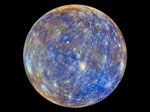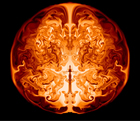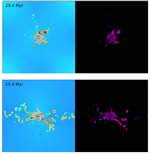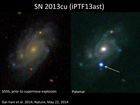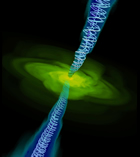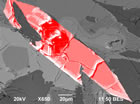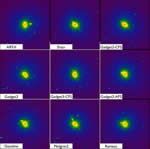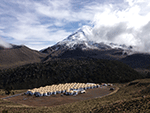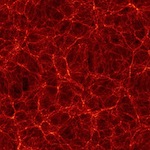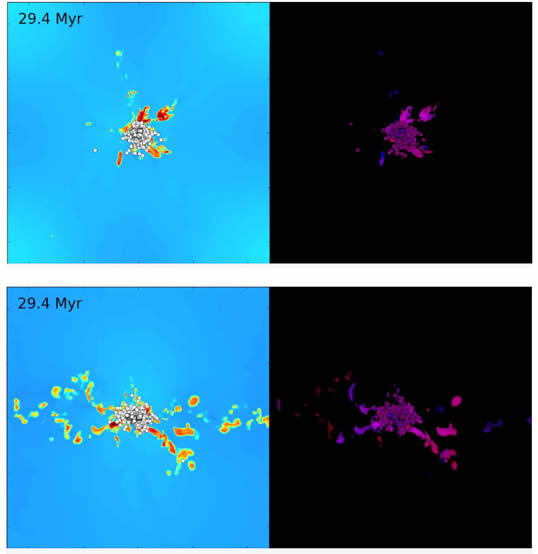Word doc
PDF (formatted and ready to go as a single newsletter page)
Separated at Birth: Finding our Sun’s Long-Lost Siblings?
Stars are born in groups or clusters when a cold giant molecular cloud collapses under its own gravitational force. If many stars form all at once—that is, if star formation efficiency is high—they will stay together as a gravitationally bound open cluster (like the Pleiades) or a globular cluster (like M13 in Hercules).
For more than a decade, it has been known that any two stars that are members of the same gravitationally bound star cluster always show the same pattern of chemical abundances. Stars are made mostly of hydrogen and helium, but they also contain traces of other elements: carbon, oxygen, iron, and even more exotic substances. By carefully measuring the wavelengths (colors) of light coming from a star, astronomers can determine how abundant each trace element is.
“The pattern of abundances is like a DNA fingerprint, where all the members of a family share a common set of genes,” said Mark Krumholz, associate professor at University of California, Santa Cruz. The pattern of abundances, set at birth, is consistent regardless of an individual star’s spectral type.
But most stellar families don’t stay together: stars don’t form fast enough for them to remain gravitationally bound, and so groups of stars drift apart, eventually even ending up on opposite sides of a galaxy. That is likely what happened with our Sun.
Thus, astronomers have long wondered whether it might be possible to tell if two stars now on opposite sides of the galaxy were born billions of years ago from the same cloud. In fact, they wondered, might it be possible to find our own Sun’s long-lost siblings?
Why such family resemblance?
Just one big problem: “Although we see that member stars of a long-lived star cluster today are chemically identical, we had no good reason to think that this would also be true of stars that were born together but then dispersed immediately,” explained Krumholz. After all, in a cloud where stars formed rapidly over a light-year apart, might the cloud not have had enough time to homogenize thoroughly, and form stars at the same time but not uniform in chemical composition?
“We didn’t really know why stars are chemically homogeneous,” he said. “Without a solid understanding of the physical mechanism that produces uniformity, everything was at best a speculation.”
So Krumholz and his graduate student Yi Feng ran a fluid dynamics simulation on UCSC’s Hyades supercomputer. They simulated two streams of interstellar gas converging to form a cloud that, over a few million years, collapses under its own gravity to make a cluster of stars. In the simulation, they added red tracer dye to one stream and blue tracer dye to the other.
Fast, early mixing
“We found that, as the streams came together, they became extremely turbulent, very effectively mixing the red and blue tracer dyes,” Krumholz recounted. By the time the cloud started to collapse and form stars, everything was purple—and the resulting stars were purple as well.
“This was a surprise,” Krumholz exclaimed. “I thought we’d get some blue stars and some red stars, instead of getting all purple stars. I didn’t expect the turbulence to be as violent as it was, and so I didn’t expect the mixing to be so rapid or efficient.”
In other runs of the simulation, Krumholz and Feng observed that even clouds that do not turn much of their gas into stars—as the Sun’s parent cloud probably didn’t—still produce stars with nearly-identical abundances.
Their findings have given the “chemical tagging” method a boost. “We’ve provided the missing physical explanation of how and why chemical mixing works, and shown convincingly that the chemical mixing process is very general and rapid even in an environment which did not yield a star cluster, like the one in which the Sun must have formed,” said Krumholz. “This is good news for prospects for finding the Sun’s long-lost siblings.” –Trudy E. Bell, M.A.
Further reading: The paper “Early turbulent mixing as the origin of chemical homogeneity in open star clusters” is published in the August 31 online issue of Nature. A UC-HiPACC press release is at http://hipacc.ucsc.edu/PressRelease/sibling-stars.html and a UCSC press release is at http://news.ucsc.edu/2014/08/star-formation.html.
The University of California High-Performance AstroComputing Center (UC-HIPACC), based at the University of California, Santa Cruz, is a consortium of nine University of California campuses and three Department of Energy laboratories (Lawrence Berkeley Laboratory, Lawrence Livermore Laboratory, and Los Alamos National Laboratory). UC-HiPACC fosters collaborations among researchers at the various sites by offering travel and other grants, co-sponsoring conferences, and drawing attention to the world-class resources for computational astronomy within the University of California system. More information appears at http://hipacc.ucsc.edu .

